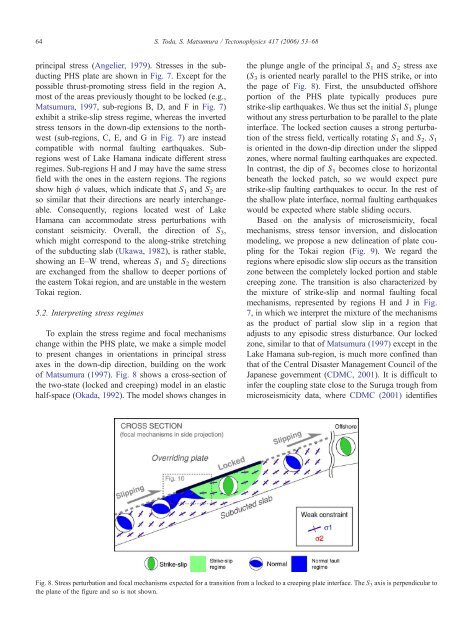Printable article - Evidence from the AD 2000 Izu Islands swarm that ...
Printable article - Evidence from the AD 2000 Izu Islands swarm that ...
Printable article - Evidence from the AD 2000 Izu Islands swarm that ...
- No tags were found...
Create successful ePaper yourself
Turn your PDF publications into a flip-book with our unique Google optimized e-Paper software.
64S. Toda, S. Matsumura / Tectonophysics 417 (2006) 53–68principal stress (Angelier, 1979). Stresses in <strong>the</strong> subductingPHS plate are shown in Fig. 7. Except for <strong>the</strong>possible thrust-promoting stress field in <strong>the</strong> region A,most of <strong>the</strong> areas previously thought to be locked (e.g.,Matsumura, 1997, sub-regions B, D, and F in Fig. 7)exhibit a strike-slip stress regime, whereas <strong>the</strong> invertedstress tensors in <strong>the</strong> down-dip extensions to <strong>the</strong> northwest(sub-regions, C, E, and G in Fig. 7) are insteadcompatible with normal faulting earthquakes. Subregionswest of Lake Hamana indicate different stressregimes. Sub-regions H and J may have <strong>the</strong> same stressfield with <strong>the</strong> ones in <strong>the</strong> eastern regions. The regionsshow high / values, which indicate <strong>that</strong> S 1 and S 2 areso similar <strong>that</strong> <strong>the</strong>ir directions are nearly interchangeable.Consequently, regions located west of LakeHamana can accommodate stress perturbations withconstant seismicity. Overall, <strong>the</strong> direction of S 3 ,which might correspond to <strong>the</strong> along-strike stretchingof <strong>the</strong> subducting slab (Ukawa, 1982), is ra<strong>the</strong>r stable,showing an E–W trend, whereas S 1 and S 2 directionsare exchanged <strong>from</strong> <strong>the</strong> shallow to deeper portions of<strong>the</strong> eastern Tokai region, and are unstable in <strong>the</strong> westernTokai region.5.2. Interpreting stress regimesTo explain <strong>the</strong> stress regime and focal mechanismschange within <strong>the</strong> PHS plate, we make a simple modelto present changes in orientations in principal stressaxes in <strong>the</strong> down-dip direction, building on <strong>the</strong> workof Matsumura (1997). Fig. 8 shows a cross-section of<strong>the</strong> two-state (locked and creeping) model in an elastichalf-space (Okada, 1992). The model shows changes in<strong>the</strong> plunge angle of <strong>the</strong> principal S 1 and S 2 stress axe(S 3 is oriented nearly parallel to <strong>the</strong> PHS strike, or into<strong>the</strong> page of Fig. 8). First, <strong>the</strong> unsubducted offshoreportion of <strong>the</strong> PHS plate typically produces purestrike-slip earthquakes. We thus set <strong>the</strong> initial S 1 plungewithout any stress perturbation to be parallel to <strong>the</strong> plateinterface. The locked section causes a strong perturbationof <strong>the</strong> stress field, vertically rotating S 1 and S 2 . S 1is oriented in <strong>the</strong> down-dip direction under <strong>the</strong> slippedzones, where normal faulting earthquakes are expected.In contrast, <strong>the</strong> dip of S 1 becomes close to horizontalbeneath <strong>the</strong> locked patch, so we would expect purestrike-slip faulting earthquakes to occur. In <strong>the</strong> rest of<strong>the</strong> shallow plate interface, normal faulting earthquakeswould be expected where stable sliding occurs.Based on <strong>the</strong> analysis of microseismicity, focalmechanisms, stress tensor inversion, and dislocationmodeling, we propose a new delineation of plate couplingfor <strong>the</strong> Tokai region (Fig. 9). We regard <strong>the</strong>regions where episodic slow slip occurs as <strong>the</strong> transitionzone between <strong>the</strong> completely locked portion and stablecreeping zone. The transition is also characterized by<strong>the</strong> mixture of strike-slip and normal faulting focalmechanisms, represented by regions H and J in Fig.7, in which we interpret <strong>the</strong> mixture of <strong>the</strong> mechanismsas <strong>the</strong> product of partial slow slip in a region <strong>that</strong>adjusts to any episodic stress disturbance. Our lockedzone, similar to <strong>that</strong> of Matsumura (1997) except in <strong>the</strong>Lake Hamana sub-region, is much more confined than<strong>that</strong> of <strong>the</strong> Central Disaster Management Council of <strong>the</strong>Japanese government (CDMC, 2001). It is difficult toinfer <strong>the</strong> coupling state close to <strong>the</strong> Suruga trough <strong>from</strong>microseismicity data, where CDMC (2001) identifiesFig. 8. Stress perturbation and focal mechanisms expected for a transition <strong>from</strong> a locked to a creeping plate interface. The S 3 axis is perpendicular to<strong>the</strong> plane of <strong>the</strong> figure and so is not shown.






